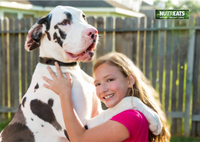Joint Health for your Puppy and Dog - Natural Supplements
Ben WintersUnderstanding Joint Health in Dogs
Recognising Changes in Your Dog’s Mobility
Since dogs cannot verbally express how they feel, it's crucial for dog owners to stay observant for less obvious signs that may indicate joint discomfort or mobility issues. Paying attention to your dog's behavior and physical capabilities can help you catch potential issues early.
Essential Signs of Mobility Issues to Observe in Your Dog
Notice if your dog hesitates or refuses to engage in activities they previously enjoyed, such as jumping onto the couch, climbing stairs, or playing fetch. This reluctance can often signal discomfort.
A noticeable decrease in activity, such as playing less, not greeting you with the same enthusiasm, or increased time spent resting and sleeping, could indicate that your dog is experiencing discomfort.
Dogs experiencing joint discomfort may find it difficult to maintain their usual grooming routine. This might result in a neglected coat, matting, or even areas of excessive licking or nibbling as they attempt to soothe themselves.
A dog in discomfort may show signs of irritability or agitation when being handled, stroked, or when interacting with other pets. They might react negatively to being touched in areas that were previously non-issues, or may become more withdrawn and less social than usual.
Observe any changes in the way your dog stands, sits, or walks. Limping, stiffness, or an awkward gait can be telltale signs of joint issues. Additionally, they might have difficulty getting up from a resting position or show signs of discomfort when lying down.
By closely monitoring these signs, you can better understand when your dog might be struggling with mobility issues. Early detection is key to managing their health effectively, allowing for timely adjustments to their care routine, diet, and activity levels to improve their quality of life.
Supporting Your Dog’s Mobility
Optimising Your Dog’s Diet and Lifestyle for Joint Health
Maintaining an ideal weight for your dog is crucial for supporting their joint health and overall mobility. Working closely with a veterinarian to tailor your dog's diet can significantly contribute to their well-being.
While the direct correlation between obesity and joint discomfort in dogs is still under study, it's well-understood that a leaner body mass can alleviate unnecessary stress on joints, potentially easing movement and enhancing quality of life.
Incorporating a balanced diet rich in essential nutrients, coupled with regular, moderate exercise, can help manage your dog's weight effectively. Such a proactive approach not only aids in preventing the onset of mobility issues but also supports robust joint function as your dog ages.
Remember, each dog is unique, and their dietary and exercise needs may vary, making personalized veterinary advice invaluable in creating an optimal health plan.

Incorporating Natural Dog Joint Supplements
Natural supplements are gaining popularity for their potential to support joint health in dogs. These can include powders, oils, and tablets made from naturally sourced ingredients.
Natural Ingredients for Joint Support
- Green-lipped Mussel: Rich in unique Omega fatty acids, green-lipped mussel products may support bone and joint health. They also provide minerals and micronutrients beneficial for your dog's wellness.
- Omega-3 Fatty Acids: Supplements high in EPA, DHA, and ETA from rich sources are recommended.
- Glucosamine: This compound supports healthy connective tissue, and supplementation may benefit dogs with joint concerns.
Choosing Natural Supplements for your dog.
The trend towards natural health solutions for pets is growing, with many pet owners looking for ways to support their dog's health naturally. Early intervention with natural supplements might help maintaining healthy mobility into your dog's senior years.






